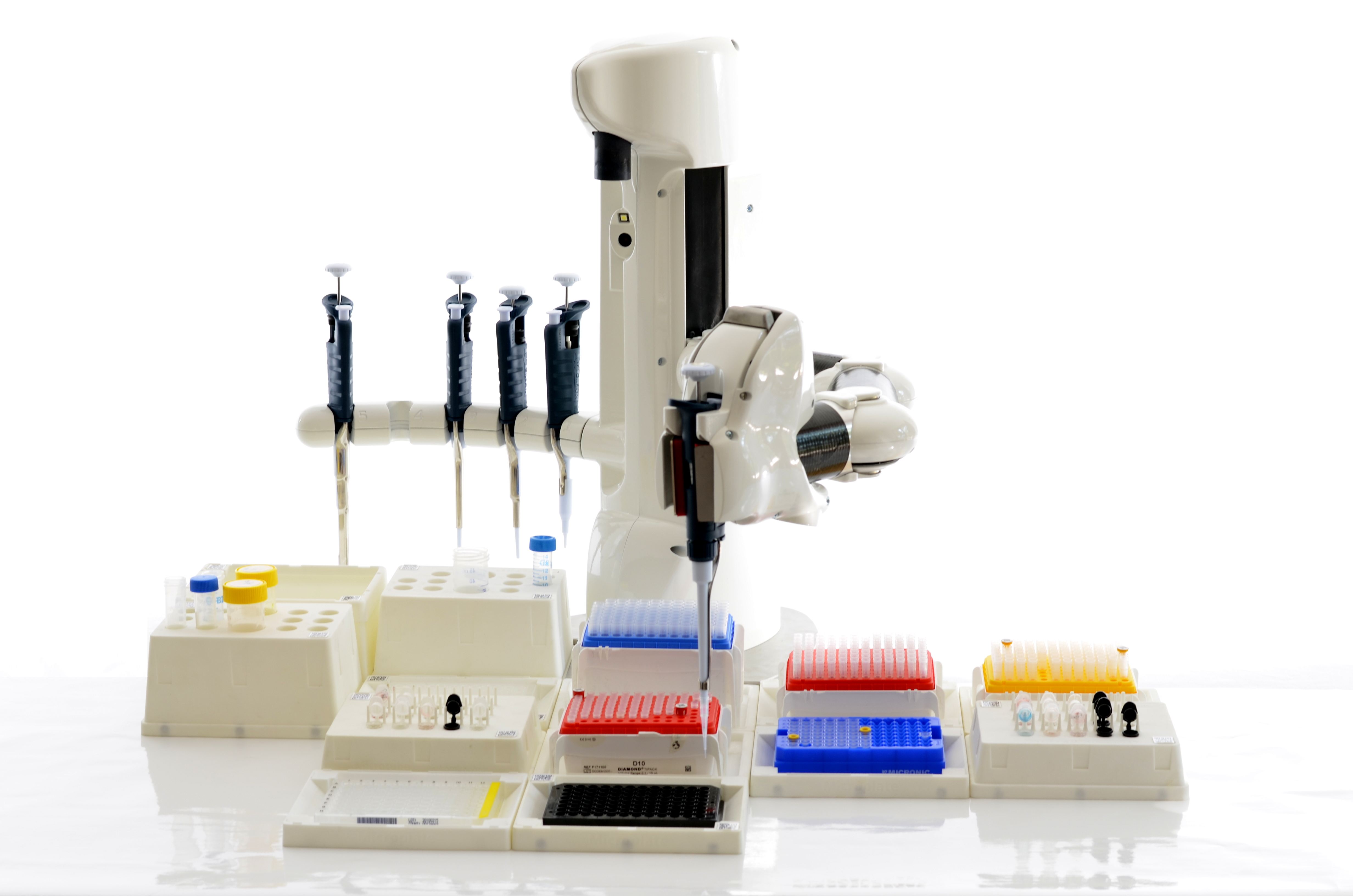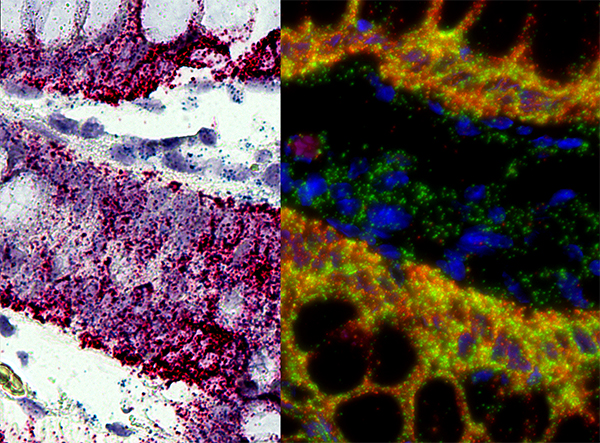|
Liquid Handling Robot
A liquid handling robot is used to automate workflows in life science laboratories. It is a robot that dispenses a selected quantity of reagent, samples or other liquid to a designated container. Introduction Liquid handling plays a pivotal role in life science laboratories. The sample volumes are usually small, at the micro- or nanoliter level, and the number of transferred samples can be huge. Under these conditions, liquid handling by hand is tedious, time-consuming, and impractical. Consequently, there is a strong demand for automated liquid handling robots. Types of liquid handling robots The simplest version simply dispenses an allotted volume of liquid from a motorized pipette or syringe; more complicated machines can also manipulate the position of the dispensers and containers (often a Cartesian coordinate robot, such as thXYZ Triton Robotfrom TriContinent Scientific) and/or integrate additional laboratory devices, such as centrifuges, microplate readers, hea ... [...More Info...] [...Related Items...] OR: [Wikipedia] [Google] [Baidu] |
Tecan LiqHandlingRobot
Tecan Group Ltd. is a Swiss company providing laboratory instruments and solutions in biopharmaceuticals, forensics, and clinical diagnostics for pharmaceutical and biotechnology companies, university research departments and diagnostic laboratories. The company focuses on the development, production and distribution of automation and detection products for life science laboratories. Founded in Switzerland, in 1980, the company has over 2100 employees, owns production and research and development sites in both North America and Europe, and maintains a sales and service network in 52 countries. In 2021, Tecan generated sales of CHF 946 million. Registered shares of Tecan Group are traded on the SIX Swiss Exchange (TECN; ISIN CH0012100191). History Engineers Heinz Abplanalp, Heini Maurer, Heinz Möckli and Gallus Blater founded Tecan (Technische Analysegeräte) on March 18, 1980, with the aim of developing measuring, analysis and laboratory automation devices. The first ... [...More Info...] [...Related Items...] OR: [Wikipedia] [Google] [Baidu] |
PerkinElmer
PerkinElmer, Inc., previously styled Perkin-Elmer, is an American global corporation focused in the business areas of diagnostics, life science research, food, environmental and industrial testing. Its capabilities include detection, imaging, informatics, and service. PerkinElmer produces analytical instruments, genetic testing and diagnostic tools, medical imaging components, software, instruments, and consumables for multiple end markets. PerkinElmer is part of the S&P 500 Index and operates in 190 countries. History Founding Richard Perkin was attending the Pratt Institute in Brooklyn to study chemical engineering, but left after a year to try his hand on Wall Street. Still interested in the sciences, he gave public lectures on various topics. Charles Elmer ran a firm that supplied court reporters and was nearing retirement when he attended one of Perkin's lectures on astronomy being held at the Brooklyn Institute of Arts and Sciences. The two struck up a friendship ... [...More Info...] [...Related Items...] OR: [Wikipedia] [Google] [Baidu] |
Acoustic Droplet Ejection
Acoustic droplet ejection (ADE) uses a pulse of ultrasound to move low volumes of fluids (typically nanoliters or picoliters) without any physical contact. This technology focuses acoustic energy into a fluid sample in order to eject droplets as small as a picoliter. ADE technology is a very gentle process, and it can be used to transfer proteins, high molecular weight DNA and live cells without damage or loss of viability. This feature makes the technology suitable for a wide variety of applications including proteomics and cell-based assays. History Acoustic droplet ejection was first reported in 1927 by Robert W. Wood and Alfred Loomis, who noted that when a high-power acoustic generator was immersed in an oil bath, a mound formed on the surface of the oil and, like a “miniature volcano,” ejected a continuous stream of droplets. Ripples that appear in a glass of water placed on a loud speaker show that acoustic energy can be converted to kinetic energy in a fluid. If the ... [...More Info...] [...Related Items...] OR: [Wikipedia] [Google] [Baidu] |
Shaker (laboratory)
A shaker is a piece of laboratory equipment used to mix, blend, or agitate substances in a tube or flask by shaking them. It is mainly used in the fields of chemistry and biology. A shaker contains an oscillating board that is used to place the flasks, beakers, or test tubes. Although the magnetic stirrer has lately come to replace the shaker, it is still the preferred choice of equipment when dealing with large volume substances or when simultaneous agitation is required. Types Vortex shaker Invented by Jack A. Kraft and Harold D. Kraft in 1962, a vortex shaker is a usually small device used to shake or mix small vials of liquid substance. Its most standout characteristic is that it works by the user putting a vial on the shaking platform and turning it on; thus, the vial is shaken along with the platform. A vortex shaker is very variable in terms of speed adjustment, for the shaking speed can be continuously changed while shaking by turning a switch. Platform shaker A p ... [...More Info...] [...Related Items...] OR: [Wikipedia] [Google] [Baidu] |
Thermal Cycler
The thermal cycler (also known as a thermocycler, PCR machine or DNA amplifier) is a laboratory apparatus most commonly used to amplify segments of DNA via the polymerase chain reaction (PCR). Thermal cyclers may also be used in laboratories to facilitate other temperature-sensitive reactions, including restriction enzyme digestion or rapid diagnostics. The device has a ''thermal block'' with holes where tubes holding the reaction mixtures can be inserted. The cycler then raises and lowers the temperature of the block in discrete, pre-programmed steps. History The earliest thermal cyclers were designed for use with the Klenow fragment of DNA polymerase I. Since this enzyme is destroyed during each heating step of the amplification process, new enzyme had to be added every cycle. This led to a cumbersome machine based on an automated pipettor, with open reaction tubes. Later, the PCR process was adapted to the use of thermostable DNA polymerase from '' Thermus aquaticus' ... [...More Info...] [...Related Items...] OR: [Wikipedia] [Google] [Baidu] |
Centrifuges
A centrifuge is a device that uses centrifugal force to separate various components of a fluid. This is achieved by spinning the fluid at high speed within a container, thereby separating fluids of different densities (e.g. cream from milk) or liquids from solids. It works by causing denser substances and particles to move outward in the radial direction. At the same time, objects that are less dense are displaced and moved to the centre. In a laboratory centrifuge that uses sample tubes, the radial acceleration causes denser particles to settle to the bottom of the tube, while low-density substances rise to the top. A centrifuge can be a very effective filter that separates contaminants from the main body of fluid. Industrial scale centrifuges are commonly used in manufacturing and waste processing to sediment suspended solids, or to separate immiscible liquids. An example is the cream separator found in dairies. Very high speed centrifuges and ultracentrifuges able to prov ... [...More Info...] [...Related Items...] OR: [Wikipedia] [Google] [Baidu] |
Pipette
A pipette (sometimes spelled as pipett) is a laboratory tool commonly used in chemistry, biology and medicine to transport a measured volume of liquid, often as a media dispenser. Pipettes come in several designs for various purposes with differing levels of accuracy and precision, from single piece glass pipettes to more complex adjustable or electronic pipettes. Many pipette types work by creating a partial vacuum above the liquid-holding chamber and selectively releasing this vacuum to draw up and dispense liquid. Measurement accuracy varies greatly depending on the instrument. History The first simple pipettes were made in glass, such as Pasteur pipettes. Large pipettes continue to be made in glass; others are made in squeezable plastic for situations where an exact volume is not required. The first micropipette was patented in 1957 by Dr Heinrich Schnitger (Marburg, Germany). The founder of the company Eppendorf, Dr. Heinrich Netheler, inherited the rights and starte ... [...More Info...] [...Related Items...] OR: [Wikipedia] [Google] [Baidu] |
In Situ Hybridization
''In situ'' hybridization (ISH) is a type of hybridization that uses a labeled complementary DNA, RNA or modified nucleic acids strand (i.e., probe) to localize a specific DNA or RNA sequence in a portion or section of tissue (''in situ'') or if the tissue is small enough (e.g., plant seeds, ''Drosophila'' embryos), in the entire tissue (whole mount ISH), in cells, and in circulating tumor cells (CTCs). This is distinct from immunohistochemistry, which usually localizes proteins in tissue sections. In situ hybridization is used to reveal the location of specific nucleic acid sequences on chromosomes or in tissues, a crucial step for understanding the organization, regulation, and function of genes. The key techniques currently in use include ''in situ'' hybridization to mRNA with oligonucleotide and RNA probes (both radio-labeled and hapten-labeled), analysis with light and electron microscopes, whole mount ''in situ'' hybridization, double detection of RNAs and RNA plus prot ... [...More Info...] [...Related Items...] OR: [Wikipedia] [Google] [Baidu] |
Immunohistochemistry
Immunohistochemistry (IHC) is the most common application of immunostaining. It involves the process of selectively identifying antigens (proteins) in cells of a tissue section by exploiting the principle of antibodies binding specifically to antigens in biological tissues. IHC takes its name from the roots "immuno", in reference to antibodies used in the procedure, and "histo", meaning tissue (compare to immunocytochemistry). Albert Coons conceptualized and first implemented the procedure in 1941. Visualising an antibody-antigen interaction can be accomplished in a number of ways, mainly either of the following: * ''Chromogenic immunohistochemistry'' (CIH), wherein an antibody is conjugated to an enzyme, such as peroxidase (the combination being termed immunoperoxidase), that can catalyse a colour-producing reaction. * '' Immunofluorescence'', where the antibody is tagged to a fluorophore, such as fluorescein or rhodamine. Immunohistochemical staining is widely used in t ... [...More Info...] [...Related Items...] OR: [Wikipedia] [Google] [Baidu] |
Tecan
Tecan Group Ltd. is a Swiss company providing laboratory instruments and solutions in biopharmaceuticals, forensics, and clinical diagnostics for pharmaceutical and biotechnology companies, university research departments and diagnostic laboratories. The company focuses on the development, production and distribution of automation and detection products for life science laboratories. Founded in Switzerland, in 1980, the company has over 2100 employees, owns production and research and development sites in both North America and Europe, and maintains a sales and service network in 52 countries. In 2021, Tecan generated sales of CHF 946 million. Registered shares of Tecan Group are traded on the SIX Swiss Exchange (TECN; ISIN CH0012100191). History Engineers Heinz Abplanalp, Heini Maurer, Heinz Möckli and Gallus Blater founded Tecan (Technische Analysegeräte) on March 18, 1980, with the aim of developing measuring, analysis and laboratory automation devices. The first ... [...More Info...] [...Related Items...] OR: [Wikipedia] [Google] [Baidu] |






